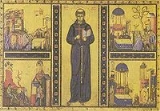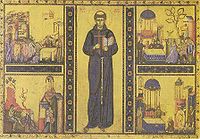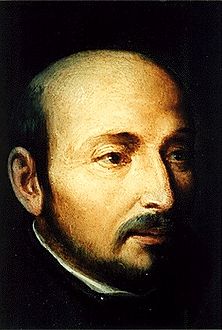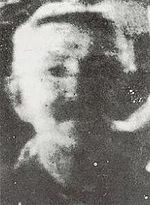
Mortification in Roman Catholic teaching
Encyclopedia
- For the theological doctrine, see Mortification (theology)Mortification (theology)Mortification refers in Christian theology to the subjective experience of Sanctification, the objective work of God between justification and glorification. Literally it means the 'putting to death' of sin in a believer's life. Reformed theologian J.I...
. - For the Christian metal band, see Mortification (band)Mortification (band)Mortification is an Australian Christian extreme metal band which was formed in 1987 as a heavy metal group, Lightforce, by mainstay Steve Rowe on bass guitar and vocals. By 1990, in the Melbourne suburb of Moorabbin, they were renamed as Mortification with the line-up of Rowe, Michael Carlisle on...
.
The Roman Catholic Church
Roman Catholic Church
The Catholic Church, also known as the Roman Catholic Church, is the world's largest Christian church, with over a billion members. Led by the Pope, it defines its mission as spreading the gospel of Jesus Christ, administering the sacraments and exercising charity...
has often held mortification of the flesh
Mortification of the flesh
Mortification of the flesh literally means "putting the flesh to death". The term is primarily used in religious and spiritual contexts. The institutional and traditional terminology of this practice in Catholicism is corporal mortification....
(literally, "putting the flesh to death"), as a worthy spiritual discipline.
Mortification in Catholic history
In the second millennium, St. Dominic LoricatusSt. Dominic Loricatus
Saint Dominic Loricatus — in Italian, San Domenico Loricato — was an Umbrian saint, born in the Italian village of Luceolis near Cantiano . His father, sensing social advancement, paid a bribe to have him ordained a priest when still a child...
is said to have performed 'One Hundred Years Penance' by chanting 20 psalters accompanied by 300,000 lashes over six days.

Francis of Assisi
Saint Francis of Assisi was an Italian Catholic friar and preacher. He founded the men's Franciscan Order, the women’s Order of St. Clare, and the lay Third Order of Saint Francis. St...
, who is said to have received the stigmata
Stigmata
Stigmata are bodily marks, sores, or sensations of pain in locations corresponding to the crucifixion wounds of Jesus, such as the hands and feet...
, painful wounds like those of Jesus Christ, is said to have asked pardon to his body, whom he called Brother Ass , for the severe self-afflicted penances he has done: vigils, fasts, frequent flagellations and the use of a hairshirt
Hairshirt
A hairshirt is a cilice, an uncomfortable shirt worn by some Catholics and, earlier, by Jews as a sign of penance. This may also refer to:*Hairshirt , a 1998 motion picture starring Dean Paras, Chris Hogan, Evan Glenn and Neve Campbell...
.
Doctor of the Church, St. Catherine of Siena
Catherine of Siena
Saint Catherine of Siena, T.O.S.D, was a tertiary of the Dominican Order, and a Scholastic philosopher and theologian. She also worked to bring the papacy of Gregory XI back to Rome from its displacement in France, and to establish peace among the Italian city-states. She was proclaimed a Doctor...
(died 1380), was a tertiary Dominican who lived at home rather than in a convent, and who practiced austerities which a prioress would probably not have permitted. She is notable for fasting and subsisting for long periods of time on nothing but the Blessed Sacrament
Blessed Sacrament
The Blessed Sacrament, or the Body and Blood of Christ, is a devotional name used in the Roman Catholic Church, Eastern Catholic Churches, Old Catholic, Anglican, and Lutheran churches, to refer to the Host after it has been consecrated in the sacrament of the Eucharist...
. St. Catherine of Siena wore sackcloth and scourged herself three times daily in imitation of St. Dominic.
In the sixteenth century, Saint Thomas More
Thomas More
Sir Thomas More , also known by Catholics as Saint Thomas More, was an English lawyer, social philosopher, author, statesman and noted Renaissance humanist. He was an important councillor to Henry VIII of England and, for three years toward the end of his life, Lord Chancellor...
, the Lord Chancellor of England, wore a hairshirt
Hairshirt
A hairshirt is a cilice, an uncomfortable shirt worn by some Catholics and, earlier, by Jews as a sign of penance. This may also refer to:*Hairshirt , a 1998 motion picture starring Dean Paras, Chris Hogan, Evan Glenn and Neve Campbell...
, deliberately mortifying his body. He also used the 'discipline
Flagellation
Flagellation or flogging is the act of methodically beating or whipping the human body. Specialised implements for it include rods, switches, the cat o' nine tails and the sjambok...
.'
Saint Ignatius of Loyola
Ignatius of Loyola
Ignatius of Loyola was a Spanish knight from a Basque noble family, hermit, priest since 1537, and theologian, who founded the Society of Jesus and was its first Superior General. Ignatius emerged as a religious leader during the Counter-Reformation...
while in Manresa
Manresa
Manresa is the capital of the Comarca of Bages, located in the geographic centre of Catalonia, Spain, and crossed by the river Cardener. It is an industrial area with textile, metallurgical, and glass industries. The houses of Manresa are arranged around the basilica of Santa María de la Seo....
in 1522 is known to have practiced severe mortifications. In the Litany prayers to Saint Ignatius he is praised as being “constant in the practice of corporal penance.” He wore a hair shirt and heavy iron chain, and was in the habit of wearing a cord tied below the knee.
St. Teresa of Ávila
Teresa of Ávila
Saint Teresa of Ávila, also called Saint Teresa of Jesus, baptized as Teresa Sánchez de Cepeda y Ahumada, was a prominent Spanish mystic, Roman Catholic saint, Carmelite nun, and writer of the Counter Reformation, and theologian of contemplative life through mental prayer...
, a Doctor of the Church
Doctor of the Church
Doctor of the Church is a title given by a variety of Christian churches to individuals whom they recognize as having been of particular importance, particularly regarding their contribution to theology or doctrine.-Catholic Church:In the Catholic Church, this name is given to a saint from whose...
, undertook severe mortification once it was suggested by friends that her supernatural ecstasies were of diabolical origin. She continued until Francis Borgia
Francis Borgia
Saint Francis Borgia, 4th duke of Gandía, 3rd Father General of the Jesuit Order, Grandee of Spain, was a Spanish Jesuit and third Superior General of the Society of Jesus. He was canonized on 20 June 1670.-Early life:He was born Francesco Borgia de Candia d'Aragon within the Duchy of Gandía,...
reassured her. She believed she was goaded by angels and had a passion to conform her life to the sufferings of Jesus, with a motto associated with her: "Lord, either let me suffer or let me die."

Marguerite Marie Alacoque
Marguerite Marie Alacoque or Saint Margaret Mary Alacoque was a French Roman Catholic nun and mystic, who promoted devotion to the Sacred Heart of Jesus in its modern form.-Early life:...
(22 July 1647 October-17 October 1690), the promoter of the devotion to the Sacred Heart, practised in secret severe corporal mortification after her First Communion at the age of nine, until becoming paralyzed, which confined her to bed for four years. Having been cured of her paralysis by the intercession of the Virgin Mary, she changed her name to Marie (French: Mary) and vowed to devote her life to the service of Mary.
Blessed Junípero Serra
Junípero Serra
Blessed Junípero Serra, O.F.M., , known as Fra Juníper Serra in Catalan, his mother tongue was a Majorcan Franciscan friar who founded the mission chain in Alta California of the Las Californias Province in New Spain—present day California, United States. Fr...
(November 24, 1713 – August 28, 1784) was a Franciscan friar who founded the mission chain in Alta California. A statue of Fr. Junipero Serra rests in Statuary Hall in the U.S. Capitol Building, representing the state of California. He was known for his love for mortification, self-denial and absolute trust in God.
An outstanding saint in the nineteenth century is St. Jean Vianney
Jean Vianney
Jean-Baptiste-Marie Vianney , commonly known in English as St John Vianney, was a French parish priest who in the Catholic Church is venerated as a saint and as the patron saint of all priests. He is often referred to as the "Curé d'Ars"...
who converted hundreds of people in laicist France. Pope John XXIII
Pope John XXIII
-Papal election:Following the death of Pope Pius XII in 1958, Roncalli was elected Pope, to his great surprise. He had even arrived in the Vatican with a return train ticket to Venice. Many had considered Giovanni Battista Montini, Archbishop of Milan, a possible candidate, but, although archbishop...
said of him: "You cannot begin to speak of St. John Mary Vianney without automatically calling to mind the picture of a priest who was outstanding in a unique way in voluntary affliction of his body; his only motives were the love of God and the desire for the salvation of the souls of his neighbors, and this led him to abstain almost completely from food and from sleep, to carry out the harshest kinds of penances, and to deny himself with great strength of soul...[T]his way of life is particularly successful in bringing many men who have been drawn away by the allurement of error and vice back to the path of good living."
During the later part of the nineteenth century, Saint Thérèse of the Child Jesus
Thérèse de Lisieux
Saint Thérèse of Lisieux , or Saint Thérèse of the Child Jesus and the Holy Face, born Marie-Françoise-Thérèse Martin, was a French Carmelite nun...
, another Doctor of the Church
Doctor of the Church
Doctor of the Church is a title given by a variety of Christian churches to individuals whom they recognize as having been of particular importance, particularly regarding their contribution to theology or doctrine.-Catholic Church:In the Catholic Church, this name is given to a saint from whose...
, at three years of age was described by her mother: "Even Thérèse is anxious to practice mortification.” And Thérèse later wrote: "My God, I will not be a saint by halves. I am not afraid of suffering for Thee.” The "Little Flower", famous for her "little way" and love of God—fasted and used the 'discipline' vigorously, "scourging herself with all the strength and speed of which she was capable, smiling at the crucifix through the tears which bedewed her eyelashes," according to one of her biographers.
In the early twentieth century, the child seers of Fatima
Our Lady of Fatima
Our Lady of Fátima is a famous title given to the Blessed Virgin Mary as she appeared in apparitions reported by three shepherd children at Fátima in Portugal. These occurred on the 13th day of six consecutive months in 1917, starting on May 13...
said they had initially seen an angel, who said: "In every way you can offer sacrifice to God in reparation
Acts of reparation
In the Roman Catholic tradition, an Act of Reparation is a prayer or devotion with the intent to repair the "sins of others", e.g. for the repair of the sin of blasphemy, the sufferings of Jesus Christ or as Acts of Reparation to the Virgin Mary...
for the sins by which He is offended, and in supplication for sinners. In this way you will bring peace to our country, for I am its guardian angel, the Angel of Portugal. Above all, bear and accept with patience the sufferings God will send you." Lucia Santos
Lúcia Santos
Lúcia de Jesus dos Santos – Sister Mary Lucy of Jesus and of the Immaculate Heart, better known as Sister Lúcia of Fátima – was a Roman Catholic Discalced Carmelite nun from Portugal...
later reported that the idea of making sacrifices was repeated several times by the Virgin Mary and that she had shown them a vision of hell
Hell
In many religious traditions, a hell is a place of suffering and punishment in the afterlife. Religions with a linear divine history often depict hells as endless. Religions with a cyclic history often depict a hell as an intermediary period between incarnations...
which prompted them to ever more stringent self-mortifications to save souls. Among many other practices, Lucia wrote that she and her cousins wore tight cords around their waists, flogged themselves with stinging nettles, gave their lunches to beggars and abstained from drinking water on hot days.

At the latter half of the twentieth century, Saint Josemaría Escrivá practiced self-flagellation and used the cilice
Cilice
A cilice was originally a garment or undergarment made of coarse cloth or animal hair used in some religious traditions to induce some degree of discomfort or pain as a sign of repentance and atonement...
, a modern-day version of the hairshirt
Hairshirt
A hairshirt is a cilice, an uncomfortable shirt worn by some Catholics and, earlier, by Jews as a sign of penance. This may also refer to:*Hairshirt , a 1998 motion picture starring Dean Paras, Chris Hogan, Evan Glenn and Neve Campbell...
. Saint Pio of Pietrelcina
Pio of Pietrelcina
Saint Pio of Pietrelcina was a Capuchin priest from Italy who is venerated as a saint in the Catholic Church. He was born Francesco Forgione, and given the name Pio when he joined the Capuchins; he was popularly known as Padre Pio after his ordination to the priesthood. He became famous for his ...
, a saint who received the stigmata
Stigmata
Stigmata are bodily marks, sores, or sensations of pain in locations corresponding to the crucifixion wounds of Jesus, such as the hands and feet...
wrote in one of his letters: "Let us now consider what we must do to ensure that the Holy Spirit
Holy Spirit
Holy Spirit is a term introduced in English translations of the Hebrew Bible, but understood differently in the main Abrahamic religions.While the general concept of a "Spirit" that permeates the cosmos has been used in various religions Holy Spirit is a term introduced in English translations of...
may dwell in our souls. It can all be summed up in mortification of the flesh with its vices and concupiscences, and in guarding against a selfish spirit... The mortification must be constant and steady, not intermittent, and it must last for one's whole life. Moreover, the perfect Christian must not be satisfied with a kind of mortification which merely appears to be severe. He must make sure that it hurts." Like St. Josemaria, Padre Pio and Mother Teresa of Calcutta used the cilice
Cilice
A cilice was originally a garment or undergarment made of coarse cloth or animal hair used in some religious traditions to induce some degree of discomfort or pain as a sign of repentance and atonement...
and discipline
Discipline
In its original sense, discipline is referred to systematic instruction given to disciples to train them as students in a craft or trade, or to follow a particular code of conduct or "order". Often, the phrase "to discipline" carries a negative connotation. This is because enforcement of order –...
regularly as means of doing penance.
Some branches of the Christian Church have also institutionalized the practice of self-inflicted penance
Penance
Penance is repentance of sins as well as the proper name of the Roman Catholic, Orthodox Christian, and Anglican Sacrament of Penance and Reconciliation/Confession. It also plays a part in non-sacramental confession among Lutherans and other Protestants...
and corporal mortification through their mandate on fasting and abstinence for specific days of the year. Christian communities in some parts of the world still practice processions of public flagellation during Lent
Lent
In the Christian tradition, Lent is the period of the liturgical year from Ash Wednesday to Easter. The traditional purpose of Lent is the preparation of the believer – through prayer, repentance, almsgiving and self-denial – for the annual commemoration during Holy Week of the Death and...
and Holy Week
Holy Week
Holy Week in Christianity is the last week of Lent and the week before Easter...
.
20th-century Catholic documents
Recent theology affirms the practice of mortification. The catechismCatechism
A catechism , i.e. to indoctrinate) is a summary or exposition of doctrine, traditionally used in Christian religious teaching from New Testament times to the present...
of the Catholic Church states: “The way of perfection passes by way of the Cross. There is no holiness without renunciation and spiritual battle. Spiritual progress entails the ascesis and mortification that gradually lead to living in the peace and joy of the Beatitudes
Beatitudes
In Christianity, the Beatitudes are a set of teachings by Jesus that appear in the Gospels of Matthew and Luke. The term Beatitude comes from the Latin adjective beatus which means happy, fortunate, or blissful....
” (n. 2015).
"Jesus' call to conversion and penance, like that of the prophets before him, does not aim first at outward works, "sackcloth and ashes," fasting and mortification, but at the conversion of the heart, interior conversion. Without this, such penances remain sterile and false; however, interior conversion urges expression in visible signs, gestures and works of penance." (CCC 1430) http://www.scborromeo.org/ccc/para/1430.htm
Pope John XXIII
Pope John XXIII
-Papal election:Following the death of Pope Pius XII in 1958, Roncalli was elected Pope, to his great surprise. He had even arrived in the Vatican with a return train ticket to Venice. Many had considered Giovanni Battista Montini, Archbishop of Milan, a possible candidate, but, although archbishop...
, who convened the Second Vatican Council, taught in Paenitentiam Agere,
an encyclical he wrote on July 1, 1962:
- But the faithful must also be encouraged to do outward acts of penance, both to keep their bodies under the strict control of reason and faith, and to make amends for their own and other people's sins... St. Augustine issued the same insistent warning: "It is not enough for a man to change his ways for the better and to give up the practice of evil, unless by painful penance, sorrowing humility, the sacrifice of a contrite heart and the giving of alms he makes amends to God for all that he has done wrong." ...But besides bearing in a Christian spirit the inescapable annoyances and sufferings of this life, the faithful ought also take the initiative in doing voluntary acts of penance and offering them to God.... Since, therefore, Christ has suffered in the flesh," it is only fitting that we be "armed with the same intent." It is right, too, to seek example and inspiration from the great saints of the Church. Pure as they were, they inflicted such mortifications upon themselves as to leave us almost aghast with admiration. And as we contemplate their saintly heroism, shall not we be moved by God's grace to impose on ourselves some voluntary sufferings and deprivations, we whose consciences are perhaps weighed down by so heavy a burden of guilt?
Pope Paul VI
Pope Paul VI
Paul VI , born Giovanni Battista Enrico Antonio Maria Montini , reigned as Pope of the Catholic Church from 21 June 1963 until his death on 6 August 1978. Succeeding Pope John XXIII, who had convened the Second Vatican Council, he decided to continue it...
also stated:
- “The necessity of mortification of the flesh stands clearly revealed if we consider the fragility of our nature, in which, since Adam’s sin, flesh and spirit have contrasting desires. This exercise of bodily mortification — far removed from any form of stoicism — does not imply a condemnation of the flesh which the Son of God deigned to assume. On the contrary, mortification aims at the 'liberation' of man.”
Pain, human nature, and Christ
Theologians also state that the SonJesus
Jesus of Nazareth , commonly referred to as Jesus Christ or simply as Jesus or Christ, is the central figure of Christianity...
, the second person of the Trinity
Trinity
The Christian doctrine of the Trinity defines God as three divine persons : the Father, the Son , and the Holy Spirit. The three persons are distinct yet coexist in unity, and are co-equal, co-eternal and consubstantial . Put another way, the three persons of the Trinity are of one being...
, united himself, as a person (through the hypostatic union), to everything human (except sin), including pain.

Christian
A Christian is a person who adheres to Christianity, an Abrahamic, monotheistic religion based on the life and teachings of Jesus of Nazareth as recorded in the Canonical gospels and the letters of the New Testament...
who is united to Jesus Christ through pain is one with his infinite act of saving the world.
This also goes together with another dictum in theology: whatever is not united (to the Divine Person) is not saved. Thus, his intellect, his will, his feelings, are all united with the Person, and are all sanctified and redeemed, including pain. Pain is therefore a sanctified and redeeming human experience.
The salvific meaning of suffering
John Paul IIPope John Paul II
Blessed Pope John Paul II , born Karol Józef Wojtyła , reigned as Pope of the Catholic Church and Sovereign of Vatican City from 16 October 1978 until his death on 2 April 2005, at of age. His was the second-longest documented pontificate, which lasted ; only Pope Pius IX ...
, who according to a recently released book on his sainthood cause practiced self-flagellation and fasting before important events, wrote an entire apostolic letter on the topic of suffering, specifically the salvific meaning of suffering: Salvifici Doloris. It is considered a major contribution to the theology of pain and suffering.http://www.vatican.va/holy_father/john_paul_ii/apost_letters/documents/hf_jp-ii_apl_11021984_salvifici-doloris_en.html
He wrote this after suffering from a bullet wound due to the assassination attempt of Ali Agca. Six weeks after meeting his attacker, he wrote about suffering in Christianity.

"Christ did not conceal from his listeners the need for suffering. He said very clearly: "If any man would come after me... let him take up his cross daily, and before his disciples he placed demands of a moral nature that can only be fulfilled on condition that they should "deny themselves". The way that leads to the Kingdom of heaven is "hard and narrow", and Christ contrasts it to the "wide and easy" way that "leads to destruction."
Christ does not explain in the abstract the reasons for suffering, but he states: "Follow me!". Come! Take part through your suffering in this work of saving the world, a salvation achieved through my suffering! Through my Cross.
Gradually, as the individual takes up his cross, spiritually uniting himself to the Cross of Christ, the salvific meaning of suffering is revealed before him. ...It is then that man finds in his suffering interior peace and even spiritual joy."
Joy in suffering
Saint Paul speaks of joy in suffering in Colossians: "I rejoice in my sufferings for your sake". He had found a source of joy in overcoming the sense of the uselessness of suffering.Faith in sharing in the suffering of Christ brings with it the interior certainty that the suffering person "completes what is lacking in Christ's afflictions"; the certainty that in the spiritual dimension of the work of Redemption he is serving, like Christ, the salvation of his brothers and sisters.
He states that it is suffering, more than anything else, which clears the way for the grace which transforms human souls. Suffering, more than anything else, makes present in the history of humanity the powers of the Redemption.
The need for prudence
The Desert FathersDesert Fathers
The Desert Fathers were hermits, ascetics, monks, and nuns who lived mainly in the Scetes desert of Egypt beginning around the third century AD. The most well known was Anthony the Great, who moved to the desert in 270–271 and became known as both the father and founder of desert monasticism...
emphasize that mortification is a means, not an end. They generally recommended prudence
Prudence
Prudence is the ability to govern and discipline oneself by the use of reason. It is classically considered to be a virtue, and in particular one of the four Cardinal virtues .The word comes from Old French prudence , from Latin...
when practicing mortification, with severe mortifications done only under the guidance of an experienced spiritual director. Consequently, practicing mortification for physical pleasure is seen as a sin. Likewise, mortification for reasons of scrupulosity
Scrupulosity
Scrupulosity is a psychological disorder characterized by pathological guilt about moral or religious issues. It is personally distressing, objectively dysfunctional, and often accompanied by significant impairment in social functioning...
(which is similar to obsessive-compulsive disorder
Obsessive-compulsive disorder
Obsessive–compulsive disorder is an anxiety disorder characterized by intrusive thoughts that produce uneasiness, apprehension, fear, or worry, by repetitive behaviors aimed at reducing the associated anxiety, or by a combination of such obsessions and compulsions...
) is considered very harmful: a contemporary example is fasting due to anorexia nervosa
Anorexia nervosa
Anorexia nervosa is an eating disorder characterized by refusal to maintain a healthy body weight and an obsessive fear of gaining weight. Although commonly called "anorexia", that term on its own denotes any symptomatic loss of appetite and is not strictly accurate...
. Catholic moral theologians recommend that the scrupulous not practice mortification, avoid persons and materials of an ascetical nature, and receive frequent spiritual direction and psychological help. 1
Not all forms of self-mortification are approved of by the Catholic Church. Practices such as the nonlethal crucifixion
Crucifixion
Crucifixion is an ancient method of painful execution in which the condemned person is tied or nailed to a large wooden cross and left to hang until dead...
s performed on Good Friday in the Philippines
Philippines
The Philippines , officially known as the Republic of the Philippines , is a country in Southeast Asia in the western Pacific Ocean. To its north across the Luzon Strait lies Taiwan. West across the South China Sea sits Vietnam...
are generally frowned upon by Catholic officials. Participants imitate various parts of the Passion of Christ
Passion (Christianity)
The Passion is the Christian theological term used for the events and suffering – physical, spiritual, and mental – of Jesus in the hours before and including his trial and execution by crucifixion...
, including his crucifixion. The spectacle draws a large amount of tourism every year.http://ipsnews.net/news.asp?idnews=37299

